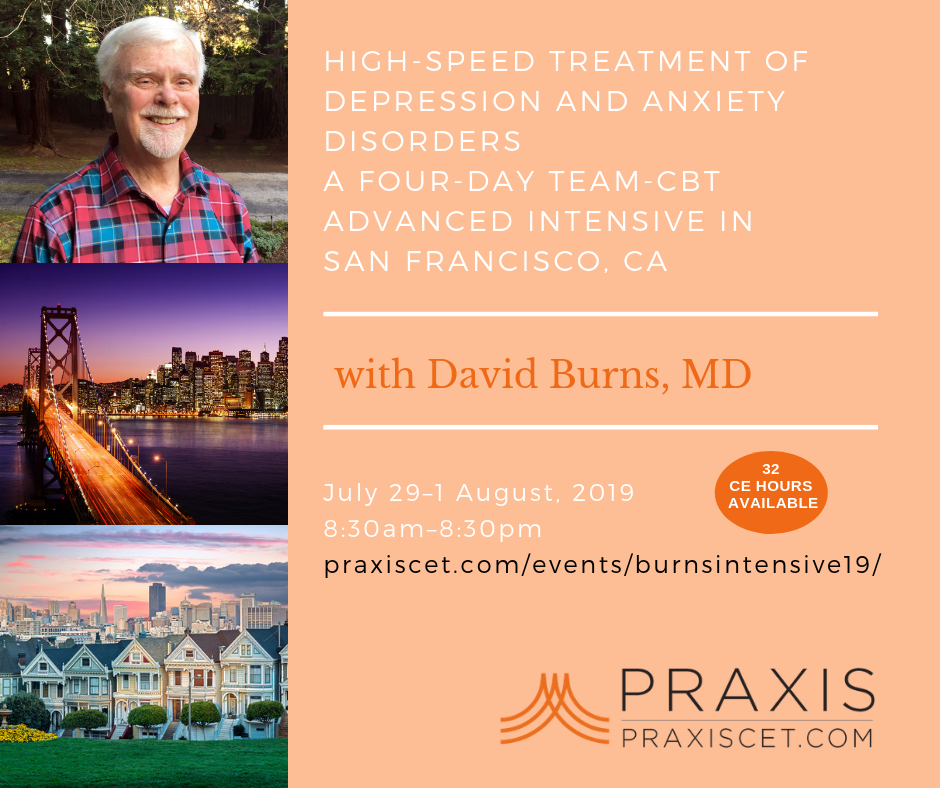By David D. Burns, MD
There have been many exciting developments in psychotherapy in the last several years. Many of them have evolved as a result of my free weekly psychotherapy training groups at Stanford for students, faculty, and community mental health professionals.
T.E.A.M.—A New Model for Psychotherapy
I am very proud to have contributed to the birth and evolution of cognitive behavioral therapy (CBT), which was one of the most important developments of 20th century psychiatry and psychology. When I first wrote my first book, Feeling Good, CBT was practically unknown. Now it has become one of the most widely practiced and researched forms of psychotherapy throughout the world. Aaron Beck, MD, Albert Ellis, PhD, and a host of other brilliant pioneers helped to create CBT, and we owe all of them an enormous debt of gratitude.
I still use CBT with great enthusiasm. However, over time a number of shortcomings in CBT have become obvious. For example, although many patients recover quite rapidly, many others seem to resist CBT, or any other type of treatment, including medications. These unfortunate individuals often struggle for years or even decades with feelings of depression, inadequacy, discouragement, anxiety, shame, guilt, and anger. Numerous controlled outcome studies indicate that roughly half of depressed patients continue to struggle, in spite of the best available treatments, including CBT, all other forms of psychotherapy, and medications as well. To my way of thinking, that’s not the best track record, and the research hints strongly that something important may be missing from nearly all current forms of treatment.
In my clinical work and research I have been asking why we have this problem. What makes therapy so amazingly fast and effective for some patients, and yet so ineffective for others? I have published my findings in research journals, including the Journal of Consulting and Clinical Psychology, Cognitive Therapy and Research, and others.
Based on this research and clinical work, I have developed a new form of therapy called T.E.A.M. which addresses and corrects some of the shortcomings in traditional CBT as well as most other forms of psychotherapy. T.E.A.M. includes CBT and much more. One way to think about it is to think of a small circle inside of a big circle. The small circle would be CBT, and the big circle would be T.E.A.M.
Before I continue I want to emphasize that the many CBT techniques that my colleagues and I have developed are still very powerful and effective for many people. I use CBT techniques–such as the Externalization of Voices, Acceptance Paradox, Interpersonal Downward Arrow, and dozens of others–with great enthusiasm. However, every new technology has to evolve, whether it’s computer chips or psychotherapy. And that’s why I developed T.E.A.M. You might think of T.E.A.M. as CBT on steroids, although that analogy is perhaps too crude, and T.E.A.M. is quite elegant–and amazing. In my workshops, I often refer to it as “therapy at warp speed,” since it can bring about results in far less time than conventional “talk therapy.”
The goal of TEAM is to produce significant and dramatic changes, and hopefully within today’s therapy session. I have rejected the notion that personal change and healing has to be a slow process, drawn out over months, years, or even decades of treatment.
T.E.A.M. is not just some new brand of psychotherapy–we have too many of those already–but rather represents the effective ingredients in all of therapy. It’s based on process research about how therapy actually works. T.E.A.M. stands for the four crucial ingredients–Testing, Empathy, (Paradoxical) Agenda Setting, and Methods.
T = Testing
We test all patients at the start and end of every therapy session so we can see exactly how much the patient has improved, or failed to improve, in several different dimensions. We can also see precisely how empathic and helpful we’ve been—or failed to be, as described below. This process makes therapists and patients alike accountable for making tangible, rapid progress, and takes the mystery out of therapy. Therapists can no longer claim they are helping patients when the assessments clearly indicate that no meaningful change is occurring. This puts therapists under pressure to learn and implement therapy techniques that actually DO work, as opposed to non-specific chatting behind closed doors for years and years.
E = Empathy
I train therapists in sophisticated empathy skills that are challenging to learn, because they require the death of the therapist’s ego. The idea is to see the world through the patient’s eyes, and to find the profound truth in what the patient is saying, even when the patient feels totally demoralized, angry or critical of the therapist. And although empathy alone will not be powerful enough to cure most patients, empathy and compassion are absolutely necessary to meaningful and effective treatment.
Research studies have revealed something fairly startling–namely, that therapists’ perception of how empathic and helpful they are can differ greatly from their patients’ perceptions. In fact, therapists’ perceptions of how their patients feel, and how their patients feel about the therapist, are usually less than 10% accurate. This means that a patient will often see his or her therapist very differently from the way the therapist sees himself or herself.
For example, the patient may not feel the therapist is particularly warm, understanding or helpful, but the therapist is simply not aware of this and thinks that he or she is exceptionally warm, understanding, and helpful. This disconnect contributes to slow recovery and even therapeutic failure.
To solve this problem, we require patients to rate the therapist in the waiting room at the end of every therapy session, using brief but exceptionally sensitive and accurate scales, and they leave these assessments for their therapists before going home. This information can be disturbing to the therapist, since most therapists initially receive failing grades from nearly every patient at nearly every therapy session. But those therapists who have the courage to use these assessments, and to review them with patients in a kindly way at the start of the next session, discover that their effectiveness can quickly soar.
A = (Paradoxical) Agenda Setting
When we are suffering, we all want to feel better. That’s for sure! No one wants to feel worthless, or anxious, or angry and at odds with the people we care about. But at the same time, there is a side to us that may resist change and cling to the status quo. And sometimes we resist change for very good reasons that reflect our deepest values and beliefs. This resistance to change is the cause of nearly all therapeutic failures. Sadly, many therapists do not have the skills to deal with resistance, so the patient and therapist may struggle for years with little or no noticeable change. Or the patient may simply give up and drop out of therapy.
Along with my colleagues, I have developed 15 powerful and innovative techniques to melt away the resistance and boost motivation quickly, before trying any methods or interventions. This nearly always accelerates recovery. In fact, we are now seeing many patients recover at speeds I would have thought impossible as little as ten years ago.
M = Methods
I have developed more than 50 powerful techniques to help individuals who are struggling with depression, anxiety, relationship problems, and habits and addictions. These include the Daily Mood Log, Identify the Distortions, the Externalization of Voices, the Acceptance Paradox, the Paradoxical Double Standard Technique, the Hidden Emotion Technique, Cognitive Flooding, the Feared Fantasy, the Relationship Journal, the Interpersonal Downward Arrow, the Intimacy Exercise (one minute drill), the Addiction / Habit Log, the Devil’s Advocate Technique, and more.
Goals
There are two goals of T.E.A.M. Therapy. The first goal is to help you develop intimacy, confidence, and self-esteem as rapidly as possible, along with a crystal clear understanding of why you’ve had to struggle with these problems in the first place. That’s called feeling better.
The second goal is to help you master powerful relapse prevention techniques so you won’t have to struggle with months or years of despair, loneliness and self-doubt in the future. Of course, no one is entitled to feel happy all the time, and we all fall into black holes of misery from time to time. But if you have the proper tools, you can quickly climb back out of that hole and experience joy again. And that’s called getting better.
Learn TEAM-CBT with David Burns, MD!

